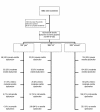Lack of awareness of erectile dysfunction in many men with risk factors for erectile dysfunction
- PMID: 21054874
- PMCID: PMC2991280
- DOI: 10.1186/1471-2490-10-18
Lack of awareness of erectile dysfunction in many men with risk factors for erectile dysfunction
Abstract
Background: Men with erectile dysfunction often have concurrent medical conditions. Conversely, men with these conditions may also have underlying erectile dysfunction. The prevalence of unrecognized erectile dysfunction in men with comorbidities commonly associated with erectile dysfunction was determined in men invited to participate in a double-blind, randomized, placebo-controlled trial of sildenafil citrate.
Methods: Men ≥30 years old presenting with ≥1 erectile dysfunction risk factor (controlled hypertension, hypercholesterolemia, smoking, metabolic syndrome, stable coronary artery disease, diabetes, depression, lower urinary tract symptoms, obesity [body mass index ≥30 kg/m2] or waist circumference ≥40 inches), and not previously diagnosed with erectile dysfunction were evaluated. The screening question, "Do you have erectile dysfunction?," with responses of "no," "yes," and "unsure," and the Erectile Function domain of the International Index of Erectile Function (IIEF-EF) were administered.
Results: Of 1084 men screened, 1053 answered the screening question and also had IIEF-EF scores. IIEF-EF scores indicating erectile dysfunction occurred in 71% (744/1053), of whom 54% (399/744) had moderate or severe erectile dysfunction. Of 139 answering "yes," 526 answering "unsure," and 388 answering "no," 96%, 90%, and 36%, respectively, had some degree of erectile dysfunction. The mean±SD (range) number of risk factors was 2.9 ± 1.7 (3-8) in the "yes" group, 3.2 ± 1.7 (3-9) in the "unsure" group, and 2.6 ± 1.5 (2-8) in the "no" group.
Conclusion: Although awareness of having erectile dysfunction was low, most men with risk factors had IIEF-EF scores indicating erectile dysfunction. Erectile dysfunction should be suspected and assessed in men with risk factors, regardless of their apparent level of awareness of erectile dysfunction.
Trial registration: ClinicalTrials.gov Identifier NCT00343200.
Figures



Similar articles
-
A multicenter, double-blind, placebo-controlled trial to assess the efficacy of sildenafil citrate in men with unrecognized erectile dysfunction.Urology. 2010 Aug;76(2):373-9. doi: 10.1016/j.urology.2010.03.017. Epub 2010 Jun 26. Urology. 2010. PMID: 20579708 Clinical Trial.
-
Safety and efficacy of sildenafil citrate in the treatment of Parkinson-emergent erectile dysfunction: a double-blind, placebo-controlled, randomized study.Int J Impot Res. 2010 Sep-Oct;22(5):325-35. doi: 10.1038/ijir.2010.23. Epub 2010 Sep 23. Int J Impot Res. 2010. Retraction in: Int J Impot Res. 2011 Mar-Apr;23(2):94. doi: 10.1038/ijir.2011.11. PMID: 20861846 Retracted. Clinical Trial.
-
Comparing vardenafil and sildenafil in the treatment of men with erectile dysfunction and risk factors for cardiovascular disease: a randomized, double-blind, pooled crossover study.J Sex Med. 2006 Nov;3(6):1037-1049. doi: 10.1111/j.1743-6109.2006.00310.x. J Sex Med. 2006. PMID: 17100937 Clinical Trial.
-
Erectile function and assessments of erection hardness correlate positively with measures of emotional well-being, sexual satisfaction, and treatment satisfaction in men with erectile dysfunction treated with sildenafil citrate (Viagra).Urology. 2006 Sep;68(3 Suppl):26-37. doi: 10.1016/j.urology.2006.06.027. Urology. 2006. PMID: 17011373 Review.
-
Erectile dysfunction diagnosis and treatment as a means to improve medication adherence and optimize comorbidity management.J Sex Med. 2013 Feb;10(2):551-61. doi: 10.1111/j.1743-6109.2012.02998.x. Epub 2012 Nov 15. J Sex Med. 2013. PMID: 23153075 Review.
Cited by
-
Phosphodiesterase-5 inhibitors for erectile dysfunction in patients with diabetes mellitus: A systematic review and meta-analysis of randomized controlled trials.Indian J Endocrinol Metab. 2015 Jul-Aug;19(4):451-61. doi: 10.4103/2230-8210.159023. Indian J Endocrinol Metab. 2015. PMID: 26180759 Free PMC article. Review.
-
Data on the utilization of treatment modalities for ED in Taiwan in the era of PDE5 inhibitors.Int J Impot Res. 2014 Jul-Aug;26(4):141-5. doi: 10.1038/ijir.2013.53. Epub 2014 Jan 23. Int J Impot Res. 2014. PMID: 24451166
-
Determinants of doctors' decisions to inquire about sexual dysfunction in Malaysian primary care settings.Transl Androl Urol. 2013 Dec;2(4):281-90. doi: 10.3978/j.issn.2223-4683.2013.09.14. Transl Androl Urol. 2013. PMID: 26816741 Free PMC article.
-
Epidemiology and Treatment Barriers of Patients With Erectile Dysfunction Using an Online Prescription Platform: A Cross-Sectional Study.Sex Med. 2020 Sep;8(3):370-377. doi: 10.1016/j.esxm.2020.04.001. Epub 2020 May 17. Sex Med. 2020. PMID: 32434669 Free PMC article.
-
Prevalence and Clinical Severity of Erectile Dysfunction in Patients Undergoing Coronary Angiography: A Descriptive Cross-Sectional Study at a Tertiary Hospital in Northern Sri Lanka.Cureus. 2025 Apr 12;17(4):e82125. doi: 10.7759/cureus.82125. eCollection 2025 Apr. Cureus. 2025. PMID: 40357080 Free PMC article.
References
Publication types
MeSH terms
Substances
Associated data
LinkOut - more resources
Full Text Sources
Medical

